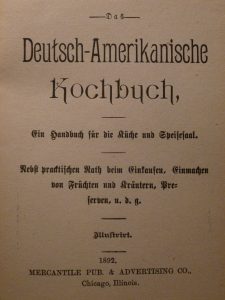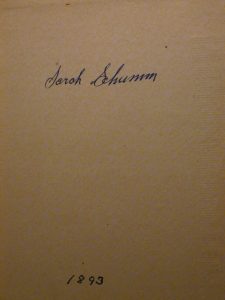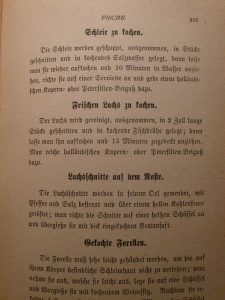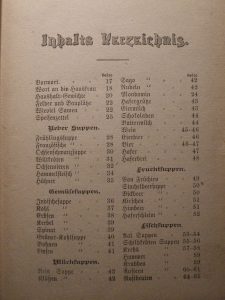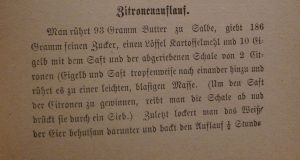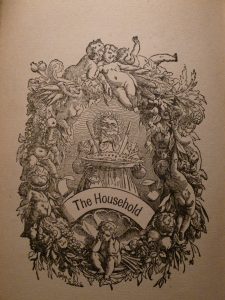While looking through some of those old German books that once belonged to my Schumm ancestors I found a very old cookbook that belonged to my great-grandmother Sarah (Breuninger) Schumm (1861-1921). She was the wife of Louis Schumm and mother of my grandfather Cornelius Schumm.
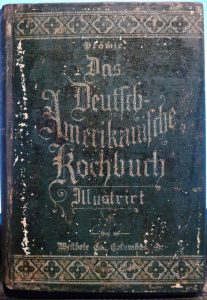
Das Deutsch-Amerikanische Kochbuch, Illustrirt, (The Illustrated German-American Cookbook), 1892, owned by Sarah (Breuninger) Schumm
This book is titled Das Deutsch-Amerikanische Kochbuch, Illustrirt, (The German-American Cookbook, Illustrated), published in Chicago, Illinois, copyrighted 1892. “The Handbook for Kitchen and Dining.”
Written inside the front cover is Sarah Schumm, 1893, likely written by Sarah herself. She would have purchased the book very soon after it was printed.
As I looked through the book I quickly noticed that it was much more German than American and that the illustrations were few and far between. It was printed in Gothic typeface in Fraktur style, a print that is hard for me to read and difficult to differentiate between certain letters.
I really do not know German. I know a couple verbal greetings—guten tag, guten morgan, guten abend–good day, good morning, good evening. I can read a tiny little bit of German, what I call “church German,” the handwritten German in church records. You really don’t need to know a lot of German to translate church records. Being able to read the old Gothic script and knowing a few key words like born, baptized, married, died, and buried is about all it takes. Being familiar with the surnames is also tremendously helpful.
At any rate, I thought it would be fun and interesting to look at some of the recipes my great-grandmother might have used over 100 years ago.
I tried to translate a couple recipes from the cookbook using Google Translate. I had moderate success and it was slow going. However my cousin Linda was able to help me with the translations. Here from Pennsylvania for our annual Miller reunion, Linda stayed at our house last weekend. She lived in Germany for about 18 years and has a pretty good working knowledge of the language. She helped translate some of those recipes and we had fun going through the book. We even came up with a sample meal menu using recipes from, which I have included at the end of this post.
We found it difficult to translate every word and some of the translations are very literal. The Germans like to combine words, making some long, descriptive words. In addition the order of the words in their sentences is unusual for us today.
The recipes are different, to say the least. They used different measurements and the recipes often do not indicate the cooking time or temperature. It makes you wonder how they controlled the temperature in a wood-fired oven.
Some examples from the Inhalts Verzeichnis (Table of Contents):
Suppen (Soups)
- Ueber Suppen (About Soups)
- Gemusesuppen (Vegetable Soups)
- Milchsuppen (Milk Soups/cream soups)
- Fruchtsuppen (Fruit Soups)
- Tilchsuppen (Table Soups)
- Weinsuppe mit Graupen (Wine Soup with Barley)
Puddinge (Puddings)
- Warme Puddinge (Warm Puddings)
- Brotpudding (Bread Pudding)
- Pfannkuchen Pudding (Pancakes Pudding)
Gemusen (Vegetables)
- Blumenkohl (Cauliflower)
Gemuse and Kartoffelspeisen (Vegetables and Potatoes)
Kloesse (Dumplings)
- Buchweizengruesskloesse (Buckwheat Dumplings)
- Reisklosse (Rice Dumplings)
Eier, Mehl und Milch-Speisen (Egg, Flour and Milk Dishes)
Salat (Salads)·
- Krabbensalat (Crab Salad)
Aspicks, Gelees, Sandwiches, etc. (Clear jellies [animal fat], Jellies, Sandwiches)
Torten (Cakes)
- Kartoffeltorte (Potato Cakes)
- Apfeltorte mit Butter Teig (Apple Cake with Butter Pastry)
- Brottorte (Bread Cake)
- Pfannkuchen (Pancakes)
Gefrorenes (Frozen)
There is a whole chapter on Knodel (Dumplings)
Below are a few of the recipes we tried to translate:
Sauerbraten (”angry” Roast Meat): 4-4 ½ pounds beef; 2 pints vinegar, 2 pints water, onion cut in two; add bay leaves, marjoram, 3-4 cloves, thyme, small tablespoon of pepper, salt; make fire, cook marinade and marinade beef for 24 hours. Put bacon on the bottom of roasting pan… [This recipe was too long and complicated and we stopped translating at this point.]
Rumauflauf (Rum Soufflé): take the peel of a lemon or apple and a little cup of rum. Follow the recipe for zitronenauflauf/lemon soufflé.
Zitronenauflauf (Lemon Soufflé): Beat 93 grams of butter and 186 grams of fine sugar; add a tablespoon of potato flower (cornstarch); mix in 10 egg yolks and the grated peel from 2 lemons. Drop egg whites and strained juice after each other into the batter. Beat the egg whites and fold into the mixture. Bake a half hour.
Schokoladen Auflauf (Chocolate Soufflé): Instead of coffee you take 62 grams of grated chocolate, 1/2 pint of cream, 93 grams of sugar, while the other is treated and finished as indicated.
As you can see, some things may have been changed or lost in the translations.
The cookbook also includes some recipes with beer and spirits. After all, the Germans like their beer.
Schaumsuppe “Foam Soup” (Sparkling Wine)
Weissweinsuppe mit Sago (White Wine Soup with Tapioca)
Rotweinsuppe mit Sago (Red Wine Soup with Tapioca)
There are also recipes for Beer Soup with Bread, White Beer Soup with Tapioca, and a recipe for Grogg.
Eierbier (Egg Beer): beat six egg yolks with 60 grams of sugar 1/4 hour then add pint of cooked [warm/heated] beer and a little bit of ginger or nutmeg.
Biersuppe zum Trinken (Beer Soup to Drink): Take a good liter of brown beer and a little bit of ginger and cook, add 2 egg yolks, a cup of sweet cream, and a little sugar, beat together and put in a cup with “toasted fine bread pieces” [croutons].
Gluehwein (“Happy Wine”): 1 bottle red wine, 93 grams sugar, lemon peel, a cinnamon stick and 6 dried cloves; simmer and strain.
This cookbook even had the 1890s German version of a Bloomin’ Onion: Zwiebeln Gebacken, in Bier-Teig (Onion Baked in Beer Batter).
I remember having at a meal at St. Paul Lutheran, Liberty Township and Bessie Regedanz made a German dish that consisted of baked onions and apples, Zwiebel mit Apfel in German. Unfortunately this cookbook did not appear to have that recipe.
The last chapter of the cookbook is Grossmutter’s Hausreglen und Ruthe—“Grandmother’s House Rules and Advice,” which includes a paragraph on what to do when someone is sick. This would probably be an interesting chapter, but it was just too difficult to translate.
Below is the menu for a traditional German meal that Linda and I put together from recipes included in the book.
A traditional German meal would start with a soup, followed by a salad. The main course would consist of meat and potatoes or dumplings. The meal would conclude with dessert. Our special German meal:
Ochsenschwanz Suppe (Ox Tail Soup)
Rotkohlsalat (Red Cabbage Salad): finely shred a small head red cabbage, sprinkle salt over top, let sit for an hour, add oil, vinegar, white pepper
Your choice of Sauerbraten (marinated roast beef or pork), or Hasenpfeffer (Rabbit)
Spatzel (Noodles)
Zitronenauflauf (Lemon Soufflé)
Disclaimer: I do not guarantee the accuracy of any of these translations. Make them at your own risk. At any rate, this book makes a nice addition to my cookbook collection, even if I can’t read it.

